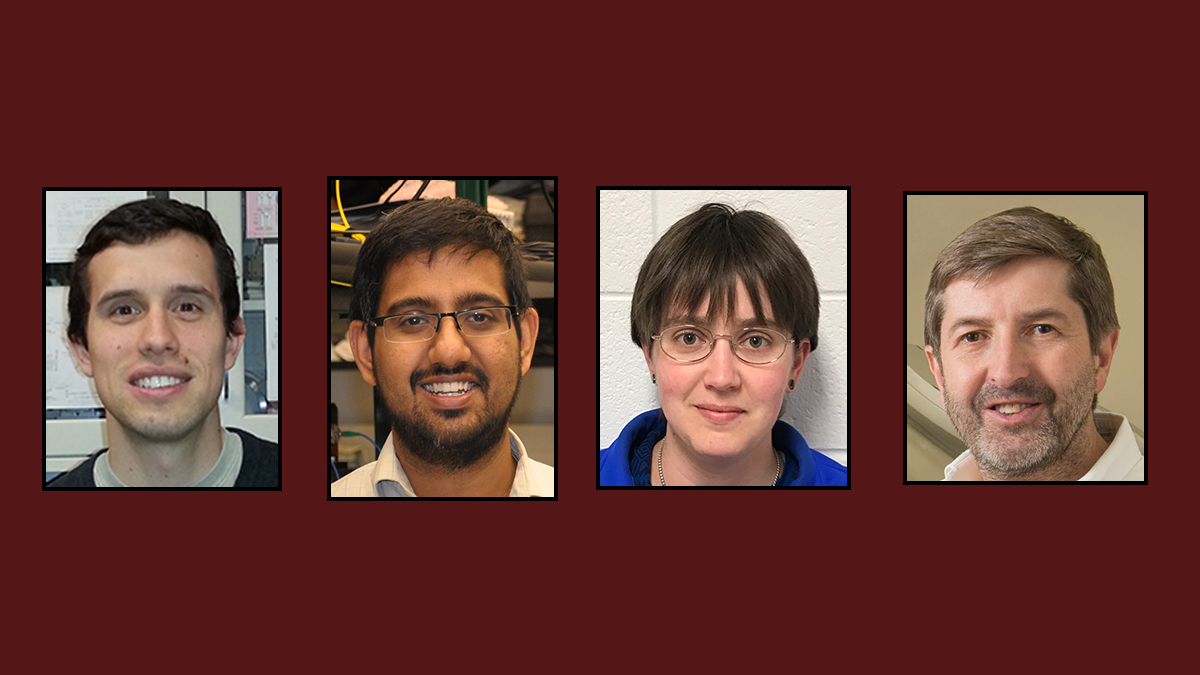
From left to right: Norbert Linke, Kartik Srinivasan, Alicia Kollár and Ronald Walsworth.
JQI has named four new Fellows in 2019, bringing the total number to 35. All four of the new arrivals have appointments in the Department of Physics at the University of Maryland. One Fellow is also a professor in the Department of Electrical and Computer Engineering at UMD and another is a physicist at the National Institute of Standards and Technology (NIST).
Norbert Linke became a JQI Fellow in January. After receiving his doctorate in atomic and laser physics from the University of Oxford, Linke joined JQI Fellow Christopher Monroe’s Trapped Ion Quantum Information group as a postdoctoral researcher in 2015.
He is now building his own research group, which will focus on using trapped ions for a wide variety of applications in quantum communication and computation. Recently, Linke has been studying ways to combine conventional and quantum computers to create hybrid machines. His efforts, which have contributed to several recent publications, may boost the limited power of the small quantum computers currently available in academic and industry labs.
In addition to his appointment as a JQI Fellow, Linke is an assistant professor in the Department of Physics at UMD and a founding member of the newly formed Quantum Technology Center (QTC), a collaboration between the Department of Physics and the Department of Electrical and Computer Engineering. He also recently served as co-chair of the 2nd North American Conference on Trapped Ions, which UMD hosted in July.
Kartik Srinivasan, who was appointed as a JQI Fellow in February, received his doctoral degree in applied physics from the California Institute of Technology.
Srinivasan is a project leader and NIST Fellow at the NIST Physical Measurement Laboratory in the Photonics and Plasmonics Group, where his lab develops nanoscale quantum devices that manipulate photons—the smallest bundles of light—with an eye toward applications in quantum information science, sensing and metrology. Recently his group has been studying new ways to generate individual photons and alter their wavelengths.
Srinivasan received a Presidential Early Career Award for Scientists and Engineers in 2010 and the Department of Commerce Bronze Medal in 2014. He recently coauthored a paper published in Nature Physics that described a device that creates entangled photons, with one at wavelengths commonly used in fiberoptic communications and another at wavelengths where atomic systems operate. Srinivasan will present at the Quantum.Tech conference in Boston on Sept. 11, and will also give talks at the Single Photon Workshop 2019 in Milan in October and the Workshop on Microcavities and Their Applications in Hong Kong in December.
Alicia Kollár arrived in August as a JQI Fellow and the Chesapeake Assistant Professor of Physics. She is also a founding member of the QTC.
Kollár earned her doctorate in applied physics from Stanford University in 2016 and was a postdoctoral researcher at Princeton University with Andrew Houck. There, she studied quantum simulations of solid-state physics and developed new techniques for creating photonic lattices.
Kollár’s group at JQI will focus on using superconducting qubits for quantum simulations, mostly of condensed matter models. The group will also pursue some theoretical questions, such as how best to mediate interactions between photons. Kollár recently coauthored a paper published in the journal Nature that proposed—and demonstrated with a proof-of-concept experiment—a method for simulating unusual geometries using an array of superconducting circuits. The result was featured in the Back Scatter section of the August issue of Physics Today.
Ronald Walsworth, who recently arrived from Harvard University and the Harvard-Smithsonian Center for Astrophysics, is the newest JQI Fellow. In additional to being the founding director of the QTC, he is a professor in the Department of Physics and the Minta Martin Professor of Electrical and Computer Engineering at UMD. Walsworth has received the Francis Pipkin Award in Precision Measurements from the American Physical Society, the Smithsonian Institution Exceptional Service Award and the Duke University Faculty Scholar Award.
At Harvard, Walsworth led a group of more than 20 scientists, postdoctoral researchers, graduate students and undergraduates and oversaw research on a host of different topics, including astrophysical spectroscopy, quantum sensing using defects in diamond and precision tests of fundamental physics. As the director of the QTC, Walsworth will lead UMD’s push to shepherd advances in basic quantum physics research from academic labs to industry.
Story by Jillian Kunze and Chris Cesare